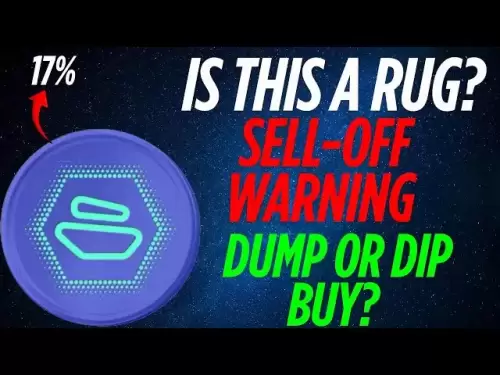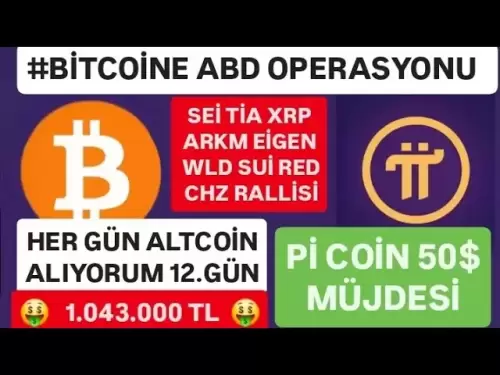-
 Bitcoin
Bitcoin $108,010.6153
-0.99% -
 Ethereum
Ethereum $2,535.1451
-1.14% -
 Tether USDt
Tether USDt $1.0002
-0.01% -
 XRP
XRP $2.2599
-0.33% -
 BNB
BNB $660.3442
-0.18% -
 Solana
Solana $149.0762
-1.43% -
 USDC
USDC $0.9999
0.00% -
 TRON
TRON $0.2866
-0.41% -
 Dogecoin
Dogecoin $0.1669
-2.73% -
 Cardano
Cardano $0.5765
-1.53% -
 Hyperliquid
Hyperliquid $38.5005
-2.98% -
 Bitcoin Cash
Bitcoin Cash $496.7709
-0.04% -
 Sui
Sui $2.8522
-2.12% -
 Chainlink
Chainlink $13.2812
-1.50% -
 UNUS SED LEO
UNUS SED LEO $9.0486
0.17% -
 Stellar
Stellar $0.2466
-2.57% -
 Avalanche
Avalanche $17.8271
-2.84% -
 Shiba Inu
Shiba Inu $0.0...01158
-1.66% -
 Toncoin
Toncoin $2.7359
-4.01% -
 Hedera
Hedera $0.1563
-1.78% -
 Litecoin
Litecoin $85.8096
-1.80% -
 Monero
Monero $313.7645
-2.86% -
 Dai
Dai $1.0002
0.02% -
 Polkadot
Polkadot $3.3494
-1.35% -
 Ethena USDe
Ethena USDe $1.0003
0.03% -
 Bitget Token
Bitget Token $4.2980
-3.40% -
 Uniswap
Uniswap $7.3906
-0.28% -
 Aave
Aave $280.1449
-2.34% -
 Pepe
Pepe $0.0...09833
-2.41% -
 Pi
Pi $0.4546
-2.21%
What is the difference between limit orders and market orders in Bitcoin trading?
In Bitcoin trading, market orders execute trades instantly at current prices, while limit orders allow price control but may not fill if the market doesn't reach your set price.
Apr 23, 2025 at 12:42 pm
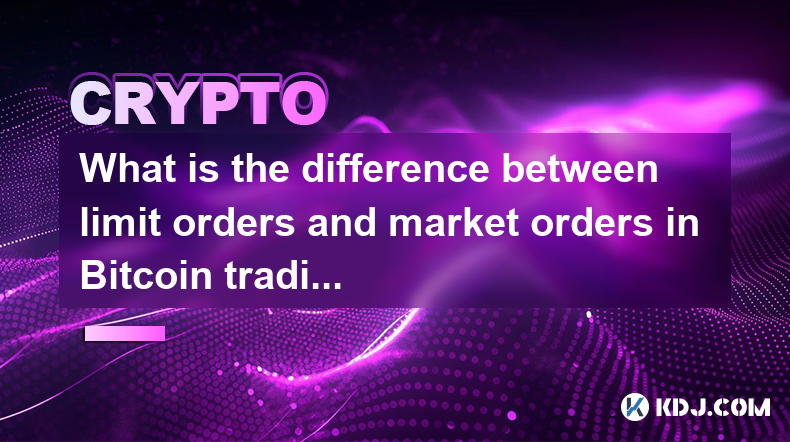
In the world of Bitcoin trading, understanding the different types of orders is crucial for effectively managing your trades. Two of the most common types of orders are limit orders and market orders. Each serves a distinct purpose and can significantly impact your trading strategy. This article will delve into the differences between these two types of orders, helping you decide which is best suited for your trading needs.
What is a Market Order?
A market order is an order to buy or sell Bitcoin at the current market price. When you place a market order, you are essentially saying that you want to execute the trade immediately, regardless of the price. This type of order is best used when you need to enter or exit a position quickly.
- Execution Speed: Market orders are executed almost instantly, making them ideal for traders who prioritize speed over price.
- Price Uncertainty: The main drawback of market orders is that you have no control over the exact price at which your order will be filled. This can lead to slippage, where the executed price differs from the expected price, especially in volatile markets.
- Liquidity: Market orders are more effective in markets with high liquidity, as there is a greater chance that your order will be filled at a price close to the current market price.
What is a Limit Order?
A limit order, on the other hand, is an order to buy or sell Bitcoin at a specific price or better. When you place a limit order, you set the price at which you are willing to buy or sell. The order will only be executed if the market reaches your specified price.
- Price Control: Limit orders give you control over the price at which your trade is executed. This can be beneficial if you have a target entry or exit price in mind.
- Execution Uncertainty: The trade-off with limit orders is that there is no guarantee that your order will be filled. If the market does not reach your specified price, your order will remain open until it is either filled or canceled.
- Strategy: Limit orders are often used by traders who have a specific trading strategy and want to ensure that they enter or exit a position at a predetermined price.
Comparing Market Orders and Limit Orders
When deciding between a market order and a limit order, it is essential to consider your trading goals and the current market conditions. Here are some key differences between the two types of orders:
- Speed vs. Control: Market orders prioritize speed and immediate execution, while limit orders prioritize control over the execution price.
- Risk Management: Limit orders can be a valuable tool for managing risk, as they allow you to set a specific price at which you are willing to buy or sell. Market orders, on the other hand, expose you to the risk of slippage.
- Market Conditions: In highly volatile markets, market orders may result in significant slippage, making limit orders a safer choice. In more stable markets, market orders can be executed with minimal slippage, making them a more convenient option.
When to Use Market Orders
Market orders are best used in situations where speed is more important than the exact price of execution. Here are some scenarios where market orders may be appropriate:
- Entering or Exiting a Position Quickly: If you need to enter or exit a position rapidly, a market order ensures that your trade is executed immediately.
- High Liquidity: In markets with high liquidity, market orders are more likely to be filled at a price close to the current market price, minimizing the risk of slippage.
- News and Events: If you are trading based on breaking news or events, a market order can help you capitalize on the market movement without delay.
When to Use Limit Orders
Limit orders are best used when you have a specific price in mind and are willing to wait for the market to reach that price. Here are some scenarios where limit orders may be appropriate:
- Target Entry or Exit Price: If you have a target price at which you want to enter or exit a position, a limit order ensures that your trade is executed at that price or better.
- Risk Management: Limit orders can be used to manage risk by setting stop-loss orders or take-profit orders at specific price levels.
- Volatile Markets: In highly volatile markets, limit orders can help you avoid significant slippage by ensuring that your trade is executed at a predetermined price.
Practical Example of Using Market and Limit Orders
To better understand how market and limit orders work in practice, let's consider a hypothetical trading scenario. Suppose you are monitoring the price of Bitcoin and believe that it is about to experience a significant price movement.
- Scenario 1: Using a Market Order: You decide to enter a long position immediately to capitalize on the expected price increase. You place a market order to buy Bitcoin at the current market price of $30,000. The order is executed instantly, and you buy Bitcoin at $30,005 due to slight slippage.
- Scenario 2: Using a Limit Order: Alternatively, you decide to wait for a dip in the price before entering your long position. You place a limit order to buy Bitcoin at $29,500. The market eventually reaches your specified price, and your order is filled at $29,500.
In this example, the market order allowed you to enter the position quickly but at a slightly higher price due to slippage. The limit order, on the other hand, allowed you to enter the position at a lower price but required you to wait for the market to reach your specified price.
FAQs
Q1: Can I use both market and limit orders in the same trading strategy?
Yes, many traders use a combination of market and limit orders to optimize their trading strategy. For example, you might use a market order to enter a position quickly and then use limit orders to set stop-loss and take-profit levels.
Q2: How do I know which type of order to use in a specific situation?
The choice between a market order and a limit order depends on your trading goals and the current market conditions. If you prioritize speed and immediate execution, a market order may be more suitable. If you prioritize control over the execution price and are willing to wait, a limit order may be more appropriate.
Q3: Are there any fees associated with market and limit orders?
Fees can vary depending on the trading platform you are using. Some platforms charge a flat fee per trade, while others charge a percentage of the trade value. It's important to check the fee structure of your chosen platform to understand the costs associated with different types of orders.
Q4: Can I cancel a limit order if the market does not reach my specified price?
Yes, you can cancel a limit order at any time before it is filled. If the market does not reach your specified price, your limit order will remain open until you decide to cancel it or it expires, depending on the settings of your trading platform.
Disclaimer:info@kdj.com
The information provided is not trading advice. kdj.com does not assume any responsibility for any investments made based on the information provided in this article. Cryptocurrencies are highly volatile and it is highly recommended that you invest with caution after thorough research!
If you believe that the content used on this website infringes your copyright, please contact us immediately (info@kdj.com) and we will delete it promptly.
- Ethereum, Exchanges, and Price Resilience: Navigating the Crypto Landscape
- 2025-07-08 08:30:13
- From Coin Flips to Cityscapes: How Names, Parks, and Planting Shaped St. Albert
- 2025-07-08 08:50:12
- Meme Coins for the Long Haul: Investing Beyond the Hype
- 2025-07-08 08:30:13
- Bitcoin, Investment, Safe Buy: Navigating the Crypto Landscape in 2025
- 2025-07-08 06:30:12
- DegeCoin, Solana, and Meme Tokens: Riding the Wave or a Wipeout?
- 2025-07-08 07:10:12
- Brett Price, Arctic Pablo, and Meme Coins: What's the Hype?
- 2025-07-08 06:50:12
Related knowledge
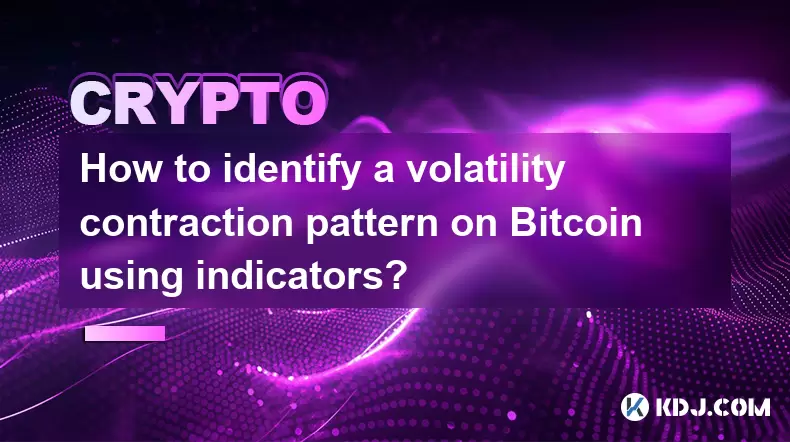
How to identify a volatility contraction pattern on Bitcoin using indicators?
Jul 07,2025 at 07:28am
What is a Volatility Contraction Pattern in Bitcoin Trading?A volatility contraction pattern refers to a phase where the price movement of an asset, such as Bitcoin, becomes increasingly narrow over time. This typically signals that the market is consolidating and may be preparing for a breakout or breakdown. In simpler terms, when volatility contracts,...

What is the Woodies CCI indicator and can it be used for Bitcoin?
Jul 04,2025 at 05:14pm
Understanding the Woodies CCI IndicatorThe Woodies CCI indicator is a variation of the traditional Commodity Channel Index (CCI), which was originally developed by Donald Lambert. The standard CCI measures the current price level relative to an average price over a given period, typically 14. However, the Woodies version modifies this calculation to mak...
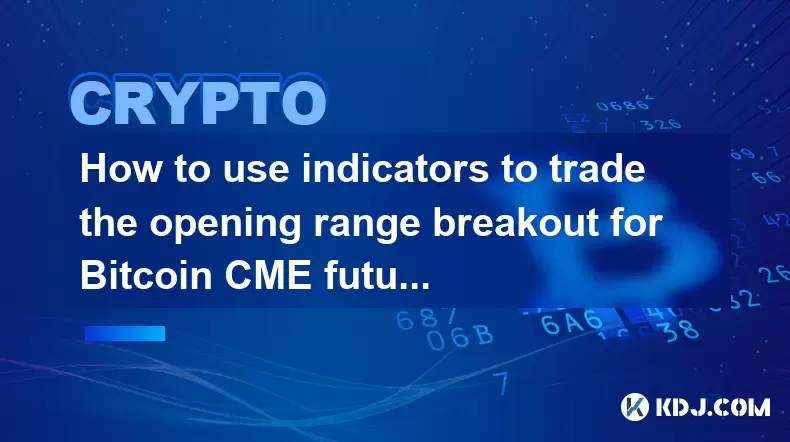
How to use indicators to trade the opening range breakout for Bitcoin CME futures?
Jul 05,2025 at 07:35pm
What Is the Opening Range Breakout Strategy?The opening range breakout (ORB) strategy is a popular trading technique used in both traditional markets and cryptocurrency futures, particularly for Bitcoin on the CME. This method involves identifying a specific price range formed during the early phase of a trading session and then taking positions when th...
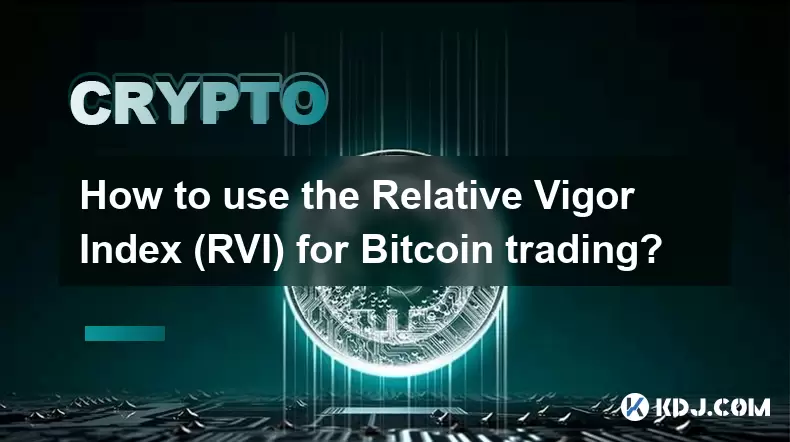
How to use the Relative Vigor Index (RVI) for Bitcoin trading?
Jul 07,2025 at 02:00pm
Understanding the Relative Vigor Index (RVI)The Relative Vigor Index (RVI) is a technical analysis tool used to assess the strength of price movements in financial markets, including cryptocurrencies like Bitcoin. It operates under the assumption that prices tend to close higher in an uptrend and lower in a downtrend. The RVI compares the closing price ...
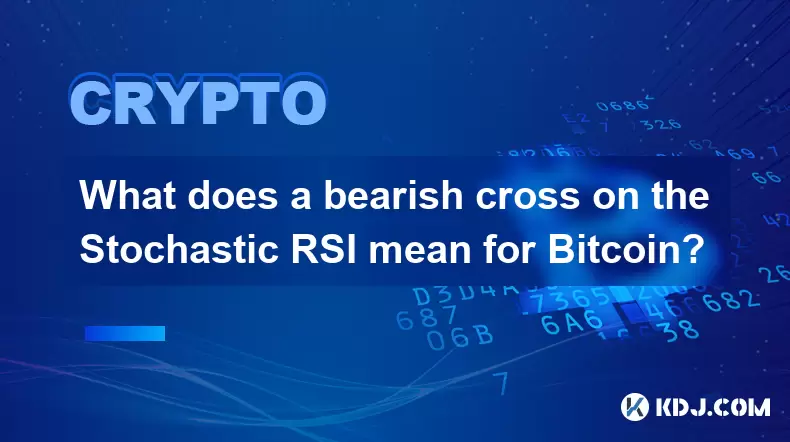
What does a bearish cross on the Stochastic RSI mean for Bitcoin?
Jul 05,2025 at 07:18pm
Understanding the Stochastic RSI IndicatorThe Stochastic RSI (Relative Strength Index) is a momentum oscillator used in technical analysis to identify overbought or oversold conditions in an asset's price. It combines two well-known indicators — the RSI and the Stochastic Oscillator — to provide more nuanced signals than either could alone. The Stochast...
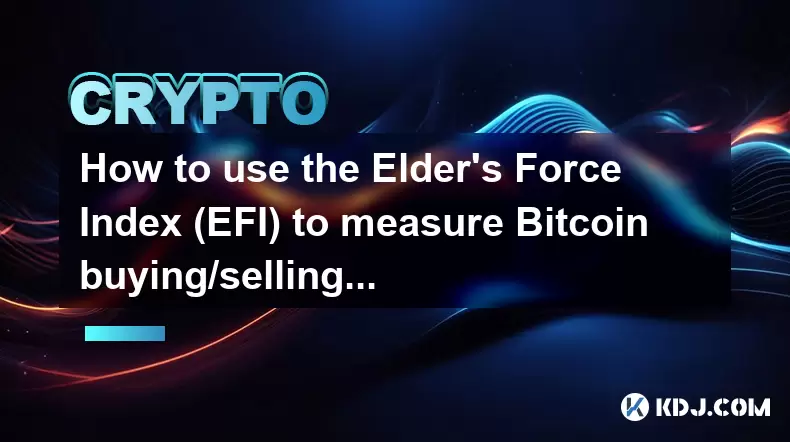
How to use the Elder's Force Index (EFI) to measure Bitcoin buying/selling pressure?
Jul 07,2025 at 02:50am
What is the Elder's Force Index (EFI)?The Elder's Force Index (EFI) is a technical indicator developed by Dr. Alexander Elder to measure the power behind price movements in financial markets. It combines both price change and volume to assess buying or selling pressure over a specific period. In the context of Bitcoin trading, EFI helps traders understa...

How to identify a volatility contraction pattern on Bitcoin using indicators?
Jul 07,2025 at 07:28am
What is a Volatility Contraction Pattern in Bitcoin Trading?A volatility contraction pattern refers to a phase where the price movement of an asset, such as Bitcoin, becomes increasingly narrow over time. This typically signals that the market is consolidating and may be preparing for a breakout or breakdown. In simpler terms, when volatility contracts,...

What is the Woodies CCI indicator and can it be used for Bitcoin?
Jul 04,2025 at 05:14pm
Understanding the Woodies CCI IndicatorThe Woodies CCI indicator is a variation of the traditional Commodity Channel Index (CCI), which was originally developed by Donald Lambert. The standard CCI measures the current price level relative to an average price over a given period, typically 14. However, the Woodies version modifies this calculation to mak...

How to use indicators to trade the opening range breakout for Bitcoin CME futures?
Jul 05,2025 at 07:35pm
What Is the Opening Range Breakout Strategy?The opening range breakout (ORB) strategy is a popular trading technique used in both traditional markets and cryptocurrency futures, particularly for Bitcoin on the CME. This method involves identifying a specific price range formed during the early phase of a trading session and then taking positions when th...

How to use the Relative Vigor Index (RVI) for Bitcoin trading?
Jul 07,2025 at 02:00pm
Understanding the Relative Vigor Index (RVI)The Relative Vigor Index (RVI) is a technical analysis tool used to assess the strength of price movements in financial markets, including cryptocurrencies like Bitcoin. It operates under the assumption that prices tend to close higher in an uptrend and lower in a downtrend. The RVI compares the closing price ...

What does a bearish cross on the Stochastic RSI mean for Bitcoin?
Jul 05,2025 at 07:18pm
Understanding the Stochastic RSI IndicatorThe Stochastic RSI (Relative Strength Index) is a momentum oscillator used in technical analysis to identify overbought or oversold conditions in an asset's price. It combines two well-known indicators — the RSI and the Stochastic Oscillator — to provide more nuanced signals than either could alone. The Stochast...

How to use the Elder's Force Index (EFI) to measure Bitcoin buying/selling pressure?
Jul 07,2025 at 02:50am
What is the Elder's Force Index (EFI)?The Elder's Force Index (EFI) is a technical indicator developed by Dr. Alexander Elder to measure the power behind price movements in financial markets. It combines both price change and volume to assess buying or selling pressure over a specific period. In the context of Bitcoin trading, EFI helps traders understa...
See all articles

























